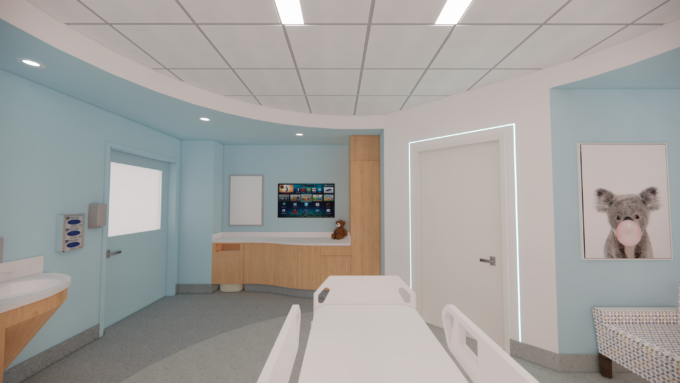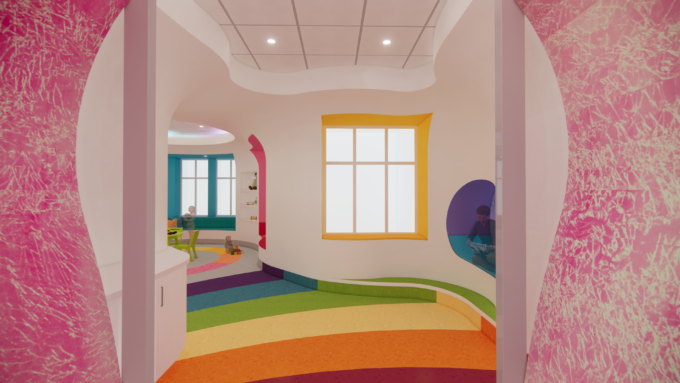From the noises and invasive testing to the time spent away from friends, a hospital stay can be traumatic to young patients. Pediatric care facilities have a unique opportunity to better support these children by minimizing these traumas and making the experience a positive and empowering one.
When we think of pediatric care, we often think of babies or toddlers as patients, but pediatric care is much more than the care of those patients. Patients in pediatric care range in age from one day old to 18 years old, and sometimes 21-years old if they are under continuous care of a physician. The “patient” is also more than just the child. In pediatric care facilities, the patient is also the family who is caring for the child, and treating the child also means caring for the entire family.
Compared to adults, pediatric patients have a wide range of unique needs and require the most sub-specialty care. Because they are still in development, they require care that is specialized for them including neonatology care, pediatric cardiology, pediatric oncology, surgery, and hospice care. Further, almost 10 million children are enrolled in the Children’s Health Insurance Program (CHIP) under Medicaid. But what is most challenging in the treatment of children are their levels of comprehension, communication, and development needs, all of which are different than those of adults.
Effect of Trauma and Major Illness on Children
As patients, children experience several psychological effects caused by the trauma of a major illness including disassociation, reconciling the effects of illness intervention from specialists, and withdrawal. There are also significant impacts to the family unit. The patient’s family is essential in providing care to children with health condition and, as such, family-centered care is the core of building a successful pediatric healthcare facility. In our recent cancer care study, “Design for Empathy: How the Environment Impacts a Cancer Patient’s Journey,” we found that family members who supported their loved ones through cancer treatment feared for their loved one, advocated for their care, and felt anxiety about the healthcare experience and their loved one’s journey. The impacts to families in the pediatric environment are similar, as members deal with stress due to separation, lack of preparedness, uncertainty, and the impact of illness on their children’s future.
Goals for Pediatric Care Design
Knowing all of this, designers and planners have a unique opportunity to act as an advocate for the child and support their needs and their family’s needs through the built environment in the following ways.
- Holistic care and attention to personalization
- An inter-disciplinary approach to illness in collaboration with the family
- Accommodate the family as “caregiver in chief,” supporting both their physical and mental needs.
- Support the child’s emotional needs by positive engagements and incorporating fun and playful activities.
- Advocacy for the child including education, prevention, and research
Traditionally, pediatric designers have focused on themed design, ‘Disneyland, main-street’ replicas, primary colors, and a focus on the development level of children under eight years old. These designs can stimulate the pediatric patient and may excite some but may do little to instill a sense of calm and healing and may not ground them to the local environment for a sense of place. While whimsical and fun, pediatric environments can do more than create a fantasy land replica of a cartoon world.
Currently, designers are focused on developing more abstract environments that incorporate art as a therapeutic distraction that connects with mobile technology for children to interact with. The immersion of technology and art provides an opportunity to create a narrative for engagement at any development level.
Beyond these pediatric-centered design strategies currently being implemented, designers and planners are looking to the future. As we learn more about how children respond to their healthcare environment, how they process trauma, and how they navigate their healthcare experience we are implementing modern, and sometimes unorthodox, solutions into pediatric designs to fully support the pediatric patient and their families.

Knowing that pediatric facilities serve more than just toddlers, designers have taken the developmental needs of each age into account. Rather than stimulate their senses with brightly colored, themed designs, designers have the power and the opportunity to consider the varying developmental needs of each patient and design spaces that support and empower patients in their healing. Our design teams have begun incorporating the following strategies
- Whimsical, non-specific environments: While themed designs and primary colors don’t install a sense of healing in patients, pediatric healthcare designers do have the opportunity to have some fun in the design. A whimsical and playful environment when done correctly, can welcome a child into the experience and help them feel less scared. In our design of Pomona Valley Hospital’s Pediatrics department, we incorporated playful colors, doorways with unique accents, separate rooms for play and treatment, and squish floors. These playful elements are meant to help children feel more comfortable and confident in their experience.
- Designing an environment that supports all age levels and adults: Children in pediatric care span a variety of age ranges and developmental stages. The needs of a toddler are vastly different than that of a teenager or young adult. So, it is important to incorporate customizable features like lighting controls, touch screens in the rooms for information or entertainment options, natural art not focused to one age group, and separate spaces to meet each patient’s needs.
- Incorporation of art, artificial intelligence (AI), and Augmented reality (AR): Art and technology are vital therapeutic elements which can help to distract the patient, immerse them in the environment, and help them advocate for themselves. Whether through a tablet, computer, or phone, children respond to technology and artificial intelligence and virtual reality strategies can empower children through their journey. When we designed artwork for the Children’s Hospital Los Angeles (CHLA) Neuro Clinic, we designed an elaborate, illustrated world of adventure with a cast of characters that could connect to any child in the clinic. Children interact with the characters’ stories painted on the walls as they navigate their way through the clinic. The stories vary depending on the reasons for a child’s visit and carry throughout the treatment rooms, with each room featuring a different character to provide variety for recurring patients. HMC’s visualization team took this illustrated interaction one-step further and has been exploring how to use AR to bring these characters to life via the patient’s phone. The hope is that by interaction on their phone, the clinic will become even more welcoming and less scary for children with the addition of some digital “friends.”
- Changeable electronic environments to connect to seasonal or holiday themes: Personalization gives patients more control over their environment and this is even more important for pediatric patients. Some pediatric patients may face a long period of time in a hospital and the personalization of their room can give them a sense of control during their treatment and make their space more playful.
- Family-focused design: Designing a pediatric healthcare environment involves more than just treatment rooms for children, it must also consider the adults who accompany them and spend long periods of time in the space. The rooms should be comfortable for non-patient caretakers to support child, sleep comfortably, and work during the day. Artwork should be appropriate, and information should be readily available and easy to find. Daybeds in the patient rooms, washer and dryer units, and separate resource rooms are important design considerations.

Children have unique developmental and emotional needs and the environment has tremendous power in responding to these needs and making pediatric patients feel safer in an intimidating healthcare facility. One size does not fit all kids and families so designing a supportive pediatric healthcare facility requires thoughtful planning. By thinking beyond the traditional design strategies, we can create spaces that minimize trauma and help children, and their families, on the path to healing.
